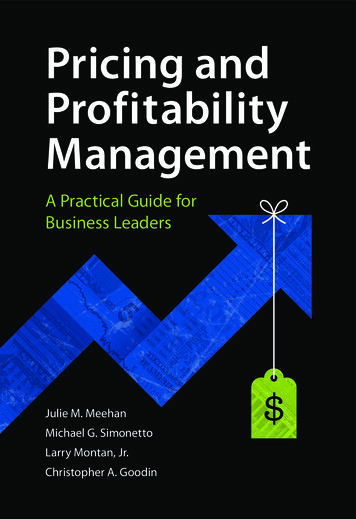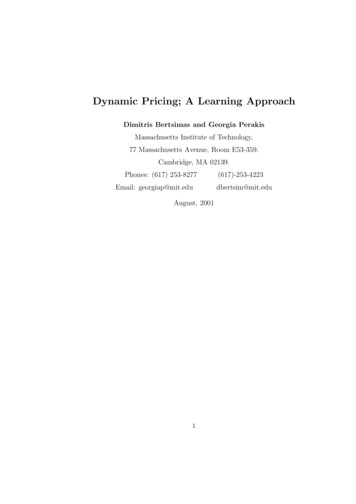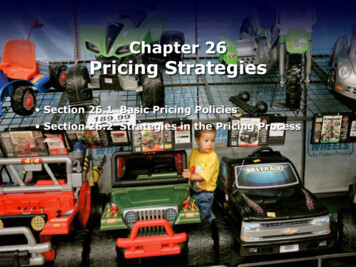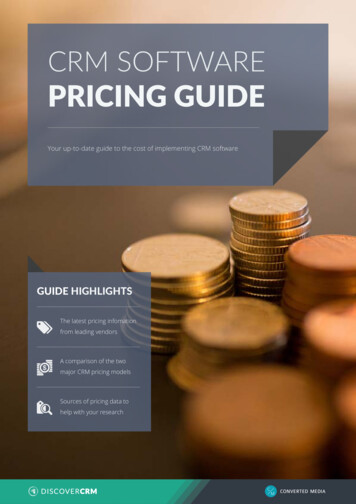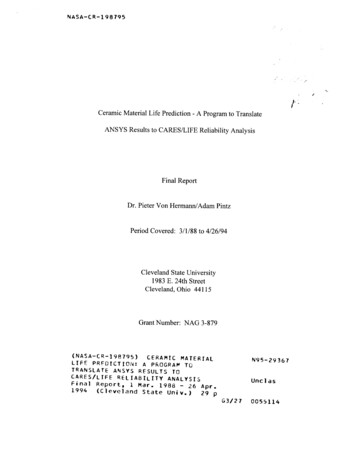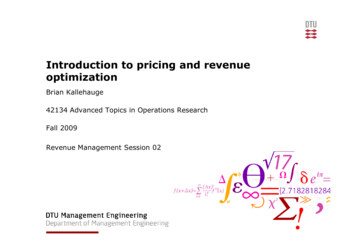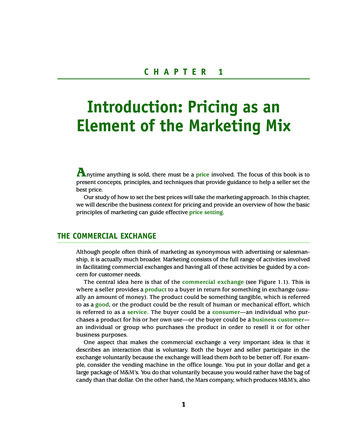
Transcription
C H A P T E R1Introduction: Pricing as anElement of the Marketing MixAnytime anything is sold, there must be a price involved. The focus of this book is topresent concepts, principles, and techniques that provide guidance to help a seller set thebest price.Our study of how to set the best prices will take the marketing approach. In this chapter,we will describe the business context for pricing and provide an overview of how the basicprinciples of marketing can guide effective price setting.THE COMMERCIAL EXCHANGEAlthough people often think of marketing as synonymous with advertising or salesmanship, it is actually much broader. Marketing consists of the full range of activities involvedin facilitating commercial exchanges and having all of these activities be guided by a concern for customer needs.The central idea here is that of the commercial exchange (see Figure 1.1). This iswhere a seller provides a product to a buyer in return for something in exchange (usually an amount of money). The product could be something tangible, which is referredto as a good, or the product could be the result of human or mechanical effort, whichis referred to as a service. The buyer could be a consumer—an individual who purchases a product for his or her own use—or the buyer could be a business customer—an individual or group who purchases the product in order to resell it or for otherbusiness purposes.One aspect that makes the commercial exchange a very important idea is that itdescribes an interaction that is voluntary. Both the buyer and seller participate in theexchange voluntarily because the exchange will lead them both to be better off. For example, consider the vending machine in the office lounge. You put in your dollar and get alarge package of M&M’s. You do that voluntarily because you would rather have the bag ofcandy than that dollar. On the other hand, the Mars company, which produces M&M’s, also1
2PRICING STRATEGIESFigure 1.1 The Commercial ExchangeProductSellerBuyerSomethingin exchange Product: good or service Buyer: consumer or business customer Something in exchange: priceSource: Adapted from W. M. Pride and O. C. Ferrell, Marketing: Concepts and Strategies (Boston: HoughtonMifflin Co).engages in this transaction voluntarily. As we know, the company would rather have yourdollar than that extra package of candy.Although we tend to take commercial exchanges for granted, we shouldn’t forget thatthere is something very important and wonderful involved here. Because both parties tothe exchange are better off after the exchange than before, one could say that the exchangemakes the world a just a little bit better place. There is a little more happiness after theexchange than before it. Although there may be only a tiny bit of increased happiness fromany one commercial exchange, these little pleasures can quickly mount up. In a societywhere the distribution of most goods and services is governed by a free-market economy,every person engages in numerous commercial exchanges every day. Each little increasein pleasure that a commercial exchange brings is then multiplied many times, and thesocietal benefits can become considerable.In all of this, it must be recognized that there are degrees of voluntariness, and thatchoices may be so limited for some buyers that they may not feel much better off after anexchange. Also, it is possible that a product purchased voluntarily could fail to perform asexpected or that a third party (other than the buyer and seller) may be harmed by anexchange. These illustrate the need for some governmental regulation—a free-marketeconomy cannot be entirely free. Nevertheless, in modern free-market societies, peopleexperience the pleasures of choice and are energized by entrepreneurial possibilities. Thecommercial exchange is at the heart of the free-market economic system, which, as wehave seen in recent years, has become more and more widely adopted among the variousnations of the world.
CHAPTER 1 Introduction: Pricing as an Element of the Marketing Mix3WHAT IS A PRICE?From this understanding of the commercial exchange, we are now able to give a formaldefinition of a price: that which is given in return for a product in a commercialexchange.This essential role of price in commerce is sometimes disguised by the use of traditionalterms. If the product in the commercial exchange is a good, then the product’s price willmost likely be called “price.” However, if the product is a service, then the product’s pricemay well go by one of a variety of other possible names (see Figure 1.2).Figure 1.2 Some Terms Used to Mean “Price”Alternative TermsWhat Is PurchasedPricemost goodsTuitioncollege courses, educationRentuse of a place to live or use ofequipment for a period of timeInterestuse of moneyFeeprofessional services: for lawyers,doctors, consultantsPremiuminsuranceFaretransportation: air, taxi, busTolluse of a road or bridge, or longdistance phone rateSalarywork of managersWageswork of hourly workersCommissionsales effortSource: Adapted from Thomas C. Kinnear and Kenneth L. Bernhardt, Principles of Marketing, 2nd ed. (Glenview, IL:Scott, Foresman and Company, 1986), 546.
4PRICING STRATEGIES“Price” Versus “Cost”Although a price may go by many names, one name it should not go by is cost. This isbecause, in this book, we will usually be taking the viewpoint of the seller.If we were taking the viewpoint of the buyer, this would not be an issue. Buyers, particularly consumers, will typically use the terms price and cost synonymously. For example,a woman could tell her friend, “The price of this sweater was only 30.” Or she could justas easily say, “This sweater cost me only 30.”However, from the viewpoint of the seller, the difference between prices and costs isquite important. A price is what a business charges, and a cost is what a business pays.Thus, a grocery manager may set a price of 3.79 for a 17-ounce box of Honey NutCheerios, may price large navel oranges at 3 for 1.99, or may sell ground chuck at theprice of 3.49 per pound. But the manager must also attend to his costs. These costsinclude, for example, what he pays the wholesaler per case of Cheerios, what he paysemployees to stock it on the shelves, what he pays for the building, for heat and lights, foradvertising, and so on.PRICING AS A MARKETING ACTIVITYMarketing activities are those actions an organization can take for the purpose of facilitatingcommercial exchanges. There are four categories of marketing activities that are particularlyimportant, which are traditionally known as the four elements of the marketing mix: Product—designing, naming, and packaging goods and/or services that satisfycustomer needs Distribution—efforts to make the product available at the times and places thatcustomers want Promotion—communicating about the product and/or the organization thatproduces it Pricing—determining what must be provided by a customer in return for the productIf you use the term place for the activities of distribution, the four elements of themarketing mix can be referred to as “the four Ps,” a mnemonic that has proved useful togenerations of marketing students.Note that there is an important way in which pricing differs from the other three elements of the marketing mix. This is illustrated in Figure 1.3. Product, distribution, andpromotion are all part of the process of providing something satisfying to the customer.Product activities concern the design and packaging of the good or service itself, distribution involves getting the product to the customer, and promotion involves communicatingthe product’s existence and benefits to customers and potential customers. All three ofthese types of marketing activities contribute to the product being of value to customers.In this book, the term value will refer to the benefits, or the satisfactions of needs andwants, that a product provides to customers.
CHAPTER 1 Introduction: Pricing as an Element of the Marketing Mix5Figure 1.3 Pricing Harvests the Value Created by the Other Three MarketingMix ElementsProductDistributionCreate valuePromotionPricing“Harvests” valueSource: Based on Nagle (1987).Pricing, on the other hand, is not primarily concerned with creating value. Rather, itcould be said to be the marketing activity involved with capturing, or “harvesting,” thevalue created by the other types of marketing activities.1 In the words of Philip Kotler, “Priceis the marketing-mix element that produces revenue; the others produce costs.”2 Becauseit is a marketing activity fundamentally different than the others, it is important that theimplications of pricing’s uniqueness be fully understood. This is one of the reasons that acourse in pricing is an important part of a business education.The Marketing ConceptThe marketing approach to business involves not only engaging in a variety of marketingactivities but also having these marketing activities be guided by the marketing concept.The marketing concept can be expressed as follows: The key to business success is to focuson satisfying customer needs.What this means is that an organization that works toward satisfying customer needs inevery feasible way when carrying out marketing activities is likely to see more long-run success than a company that does not have such a customer focus. Sellers who rely only on theirown opinions and ignore those of their customers or sellers who view their customers as“marks” to be tricked or manipulated may do well at a particular time but are unlikely to beable to sustain whatever short-term success they may have. The marketing concept is a modernform of the philosophical viewpoint known as “enlightened self-interest”: One’s self-interestis best served by focusing one’s attention on the needs of others.
6PRICING STRATEGIESPricing and the Marketing ConceptIt is clear how product, distribution, and promotional activities can be guided by the marketing concept. Through marketing research (which, by the way, is a fifth important category of marketing activities), a personal computer manufacturer can learn, for example,the features and styling consumers want and then build machines to satisfy consumerpreferences. A bank could determine the hours consumers would prefer walk-in serviceand could arrange to have those services available during those hours. A cell phone serviceprovider may find out that many consumers are unaware of all of the convenient featuresof their service and may design a promotional program to communicate this information.However, it is less clear how pricing activities can be guided by the marketing concept.Certainly, customers would prefer paying less. In fact, paying nothing at all might well be theirfirst choice! But it is simply not feasible to “give away the store.” An organization that gives awaythe value it creates will soon cease to exist, and thus the value it creates will disappear. This doesnot serve customers well. Rather, it is in the customer’s interest for an organization that createscustomer value to set prices that maximize the organization’s profitability, since that would givethe organization the greatest possible chance of continuing to create that value.Lest this endorsement of profit maximization sound somewhat extreme, rest assuredthat in a free-market system, competition will tend to keep maximum profits modest.Nothing attracts competitors more quickly than a highly profitable product. Further, themarketing concept points the price setter to consider not only the customer value that canbe harvested but also the customer’s feelings about the price that is being charged.Examples of such price feelings that need to be considered include the following: The feeling of a price being substantially higher than the customer’s expectations(sometimes referred to as “sticker shock”) The feeling that a price is unfair or is higher than can be justified Customers perceiving they are receiving a discount, or a price lower than theirexpectationsIt is important to note that both identifying the value that the product represents to thecustomer and considering customers’ price expectations and feelings depend onunderstanding and attending to customer needs. Both of these aspects of the marketingapproach to pricing will be discussed in detail in later chapters.EARLY PRICING PRACTICESAs you might imagine, the practice of pricing has a very long history. Consider thefollowing:The oldest records of prices ever found are clay tablets with pictographic symbols found in atown known as Uruk, in what was ancient Sumer and what is now southern Iraq. Theseprice records are from 3300 BC—they’ve survived 5,300 years. The documents—records ofpayment for barley and wheat, for sheep, and for beer—are really receipts. “Uruk was a
CHAPTER 1 Introduction: Pricing as an Element of the Marketing Mix7large city, at a minimum 40,000 people,” says UCLA professor Robert Englund, one of thefew experts on the Uruk documents. “So some of the quantities are very high—hundreds ofthousands of pounds of barley, for instance.”But here’s the really remarkable thing. The earliest Uruk tablets aren’t just the oldestpricing records ever found. They are the oldest examples of human writing yet discovered.In other words, when humans first took stylus to wet clay, the first things that they were3compelled to record were . . . prices.In the earliest commercial exchanges, goods or services were exchanged for othergoods or services. For example, the price that a farmer might pay for a bolt of clothcould be a bushel of corn. This practice, termed barter, still goes on today, especiallyin less developed countries. Barter occurred in recent years when Shell Oil purchasedsugar from a Caribbean country by giving in return one million pest control devices.4Although barter is still used, it can make exchange difficult. For example, what if theseller of the bolt of cloth had no need for the farmer’s bushel of corn? Because of suchinefficiencies of barter, almost all modern commercial transactions use a medium ofexchange—something that is widely accepted in exchange for goods and services in amarket.5A medium of exchange could be anything that the buyers and sellers in a society agreeupon. In the past, items such as cattle, seashells, dried cod, and tobacco have been used asa medium of exchange. However, many of these presented certain difficulties. In his bookThe Wealth of Nations, Adam Smith gives an example of this:The man who wanted to buy salt, for example, and had nothing but cattle to give inexchange for it, must have been obliged to buy salt to the value of a whole ox, or a wholesheep, at a time. He could seldom buy less than this, because what he was to give for itcould seldom be divided without loss. . . . 6Over time, it became clear that the best medium of exchange is one that is finely divisible, such as the metals of various weights used in coins. This use of coins and notes torepresent them led to national systems of money, such as dollars, yen, or euros. It is pricesexpressed in such monetary terms that will be considered in this book.THREE CATEGORIES OF PRICING ISSUESAs the use of prices in monetary terms proliferated among human societies, various questions that required pricing decisions began to arise. Most of these issues fall into one of thefollowing three categories: (1) buyer–seller interactivity, (2) price structure, and (3) priceformat.Buyer–Seller Interactivity in Determining PricesThroughout most of history, prices were not the fixed amounts displayed in stores andadvertising that are so familiar today. Rather, prices were negotiated during an interaction
8PRICING STRATEGIESbetween the buyer and the seller. The basic elements of price negotiation can be illustrated by imagining how, for many centuries, the price determination process typicallyoccurred:A customer arrives at the seller’s stall in the local marketplace and examines themerchandise. When he finds something he wants, the customer asks the seller, “Howmuch?” The seller then states an asking price, which is higher than his reservation price,the lowest price at which he would sell the item: “23 ducats.” The customer then states hisinitial offer. This, of course, is lower than the customer’s reservation price (the highest pricethat the customer would pay for the item): “I can’t pay more than 14.”The seller and the customer would then try to arrive at an amount they can both agreeon by haggling, a process involving some number of prices and offers and statementssupporting the validity of each. “This item is really of the very highest quality,” the sellermight argue, “but since I’m in a good mood today, I’ll let you have it for 21.” The customermight respond, “I’ve seen items at least as good as this in other shops, but since I’m here, I’llgive you 16.”If there is overlap between the reservation price of the seller and that of the customer,then they could be successful in arriving at a negotiated price—that is, one that isagreeable to both. In that case, the object’s price would have been the number thatresulted from an interaction between the buyer and seller. A price arrived at by thebuyer–seller interactions of negotiation or the interactions of auction bidding would bereferred to as an interactive price.If you find yourself a little uncomfortable with the deception involved in the process ofprice negotiation, you are not alone. Religious leaders were among the earliest criticsof this type of business practice. In fact, it was George Fox, the founder of the Society ofFriends (often called the Quakers), who first suggested that an alternative was possible. Heled his followers to carry over to their businesses the principle of total honesty that theyadhered to in their personal lives. As a result, Quaker merchants adopted the practice ofstating to the customer the price that they actually expected to receive and sticking to it.Such a price is referred to as a fixed price.It is interesting that, rather than hurting their competitive position, the use of fixedprices actually tended to help the Quakers in their businesses. Customers appreciated thequicker and less stressful buying process associated with fixed prices and often tended tofeel more trusting of Quaker merchants. The use of fixed prices spread steadily and wasstrongly stimulated by the development, in the middle of the nineteenth century, of newtypes of retailing designed to serve mass markets. In particular, fixed prices helped makepossible the large department store (pioneered by entrepreneurs such as F. W. Woolworth,John Wanamaker, and J. L. Hudson), which depended on a large number of quick transactions and staffing by low-paid, relatively unskilled clerks. In an 1859 advertisement for hisgrowing New York department store, Rowland Macy claimed, “Best products, and sameprices for all customers!” Also, the use of fixed prices enabled the growth of mail-ordersales and the development of large catalog companies such as Sears Roebuck.7During the twentieth century, the use of fixed prices became predominant in retail pricing throughout the developed world. Although we take fixed prices for granted when we
CHAPTER 1 Introduction: Pricing as an Element of the Marketing Mix9shop, for example, in department stores, grocery stores, drugstores, hardware stores, orbookstores, the purchase of expensive items such as automobiles or real estate still usuallyinvolves price negotiation. Also, in contrast to most retailers (companies that sell directlyto consumers), companies that sell to business customers are likely to make heavy use ofprice negotiation. The issues involved in buyer–seller interactivity in pricing will be discussed in more detail in a later chapter.Price StructureAlthough there are benefits to moving from negotiated prices to fixed prices, there are alsodisadvantages. One strength of interactive pricing is that it makes it easy for the seller tocharge different prices to different buyers. For example, when prices are negotiated individually, a customer willing to pay a particularly high price could be charged, say, 200 foran item without interfering with the seller’s ability to charge more typical customers alower price, say, 125 for the same item. The practice of charging different customers different prices for the same item is known as price segmentation.In order to accomplish price segmentation with fixed prices, it is necessary to have morethan one price for a single product. For example, a product may have one price when purchased alone and another price when purchased in large quantity or when purchasedalong with other items. The product may have one price when purchased during the weekand another when purchased on a weekend. It may have one price when purchased in thecity and another when purchased in a rural area. These numerous prices for an item arepart of the pattern of the seller’s prices. In general, the pattern of an organization’s pricesis known as its price structure.The price structure of a seller involves more than the array of prices that can becharged for the same item. Most organizations sell more than one product, and thepattern of prices across these different products is another component of the organization’s price structure. Often the various products are interrelated such that the pricecharged for one item should take into account the prices charged for other items soldby the organization.Price FormatThe third category of pricing issues involves how a price is expressed when it is communicated to potential customers. For example, early fixed prices tended to be round numbers, such as 1.00, 5.00, or 2.50. However, by 1880 retail advertisements began toappear showing items priced at a penny or two below the round number (see Figure 1.4).The practice of pricing an item just below a round number does not substantially affect thelevel of a price, but it does affect how that price level is expressed. The form of expressionof a price is known as the price format.Expressing a price in a “just-below” format often has the effect of lowering the price’sleftmost digit. This may make the price level appear lower than it actually is and have apositive effect on sales. It is sometimes suggested that early retailers used this technique asa means of reducing dishonesty among clerks. For example, a price such as 1.99 wouldoblige employees to use the cash register to make change and thus reduce their opportunity to
10PRICING STRATEGIESFigure 1.4 Macy’s Ad From 1880, Showing 9-Ending PricesSource: New York Times, 1880.pocket the payment. However, research on early price advertising has indicated that justbelow prices were more likely to be used when the advertised item was claimed to be adiscount or an otherwise low price. This suggests that the use of the just-below price format
CHAPTER 1 Introduction: Pricing as an Element of the Marketing Mix11was, from the start, motivated by managerial intuitions about its effects on the perceptionsof the consumer.Price format also involves the question of how many numbers are required to expressan item’s price. For example, a price advertisement could directly show the price of a mushroom and pepperoni pizza, or it could express that price as a base price plus an additionalamount for the two toppings (see Figure 1.5). The price of a lamp in a home furnishingscatalog might be expressed as a price for the lamp that includes shipping or as a price forthe lamp alone along with a separate price for the shipping of the lamp to the purchaser.The question of whether a price should be expressed as a single number or as the sum ofmore than one number is the issue of price partitioning.Figure 1.5 Alternative Price Formats for a Mushroom and Pepperoni PizzaPizzaHeavenPizzaHeavenPrices:Prices:Cheese & tomato 9.99Cheese & tomatowith mushrooms 10.99Cheese & tomatowith mushrooms andpepperoniCheese & tomato 9.99For each additional topping 1.00Available toppings:Mushrooms, pepperoni 11.99THE PRICING ACTIVITYThe marketing activity of capturing the value created by the other marketing activities isobviously of essential importance to a business organization. One could imagine an organization failing to carry out distribution or promotion activities and still be in business. Butif there is no attention to pricing, a business organization cannot be viable.The activity of making decisions about prices consists of two general components. Onecomponent is price setting, which consists of decisions about individual prices. These decisions concern the price of a specific item to a specific customer or market in the current
12PRICING STRATEGIESmarketing environment or situation at hand. The other component of the pricing activityis establishing pricing policy, which involves decisions that guide and regulate the settingof individual prices. This guidance could be general, such as a “fixed-price policy,” whichwould require the organization to maintain fixed prices. It could also be more specific, suchas indicating the situations when it would be permissible for the organization to offervolume discounts. Broadly, pricing policies are the organization’s rules that govern particular price-setting decisions.Participants in the Pricing ActivityIn a small business organization, the owner/manager will be heavily involved in, and mostresponsible for, pricing activities. In a large business organization, it is likely that manypeople within the organization will play a role in pricing activities.Some of the individuals in a large organization who play a role in pricing will havevery direct pricing involvement and responsibility. Here are some examples of suchdirect roles: In a department store, it is usually the merchandise buyer who will do most of theprice setting for the items he or she buys to be sold in the store. In many large consumer products organizations, a brand’s product manager willhave much of the responsibility for setting the prices of a brand. In companies that sell to business customers, salespeople and their managersplay a crucial role in the negotiation processes by which prices aredetermined. In service industries, such as airlines and hotels, there will often be pricingdepartments with specialists trained in revenue management, a set of complexprice-setting techniques that are frequently used in these industries.8There are also likely to be many people in a large organization who participate in pricingactivities but who do so in a way that is less direct. For example, employees in the accountingdepartment often provide information about the costs of products and of the operationsinvolved in getting products to the customer; accurate cost information is essential for effectiveprice setting. Lawyers and others in the legal department could establish legal and ethicalguidelines for pricing and could adjust proposed prices to comply with relevant laws andcontracts. Analysts in the finance department may be involved in assessing the degree to whichpricing schedules developed by product or sales managers are consistent with the profit goalsof the organization. In many large business organizations, higher-level managers are involvedin approving, and perhaps revising, proposed price schedules.Organization of Pricing ActivitiesParticularly because of the likely involvement in pricing activities of many people withindifferent parts of a large business organization, it is somewhat surprising that many companies do not have a means to effectively coordinate pricing-related decisions across
CHAPTER 1 Introduction: Pricing as an Element of the Marketing Mix13departments in the company.9 For pricing decisions to be made effectively in a large organization, it is important that these decisions either involve high-level management in theorganization or use some other means to centrally coordinate and constrain the manypricing-related decisions that are likely to be made by many different people throughoutthe organization.10 There are at least three reasons why such organization of pricing activities is important.First, it is possible for a large company to experience problems in the effective implementation of pricing decisions. For example, the product manager of a manufacturingcompany that sells to distributors and retailers may set an item’s invoice price—the priceof the item that will appear on the customer’s bill. However, a large or longtime customermay be able to convince his or her sales representative into offering a small off-invoicediscount—say, an annual volume rebate. Further, the customer may contact the company’sadvertising department and arrange a small discount for, say, displaying the product in thecustomer’s flyers. The accounts receivable department may be convinced to give this goodcustomer more favorable payment terms, the transportation department might give thiscustomer a break on shipping costs, and the account services department could allow thiscustomer a more generous return policy. Employees in each part of the company might beassuming that it makes sense to give a break to such a good customer. However, together,all of these actions may substantially reduce the item’s pocket price—the amount that’sactually left in the company’s pocket after the transaction. Without central pricing coordination, such revenue “leaks” could be as high as 20 percent of invoice prices.11Second, a business organization should take steps to help insure that everyday pricingdecisions fit with the organization’s strategies and long-term interests. As will be seen inlater chapters, pricing decisions made for immediate purposes can have consequences thatare far-reaching. For example, price cutting done in response to competition can lead toprice warfare and serious erosion of profits. Recent financial difficulties among companiesin the U.S. airline industry may be, at least partly, a cons
marketing mix can be referred to as “the four Ps,” a mnemonic that has proved useful to generations of marketing students. Note that there is an important way in which pricing differs from the other three ele-ments of the marketing mix. This

